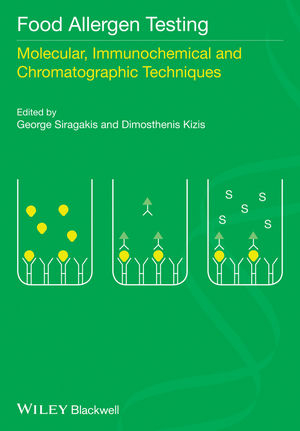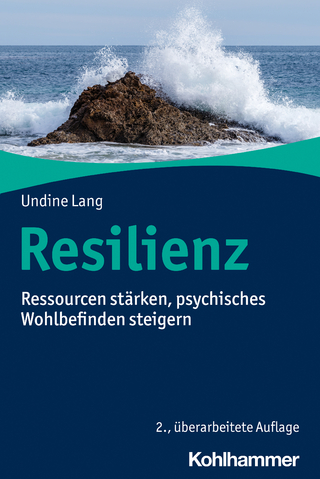
Food Allergen Testing
Wiley-Blackwell (Verlag)
978-1-118-51920-2 (ISBN)
- Titel z.Zt. nicht lieferbar
- Versandkostenfrei innerhalb Deutschlands
- Auch auf Rechnung
- Verfügbarkeit in der Filiale vor Ort prüfen
- Artikel merken
An in-depth review of the current scientific knowledge on food allergens testing, covering the major methodologies and techniques used to detect food allergens. Food allergens are a series of agents, mainly proteins, which cause various unpleasant and sometimes clinical symptoms in humans through consumption of foods.
Perhaps surprisingly, there are no treatments against food allergies which have been found to be 100% effective. The scope for individual difference in terms of how a person reacts to a given allergen is massive, making it incredibly difficult and complex to try and medicate against allergies.
Food Allergens Testing takes a thorough look at modern molecular biology and immunochemical techniques used to detect food allergens. The eleven chapters constitute an in-depth review of the current scientific knowledge on food allergens, covering the major methodologies and techniques used in validated analytical approaches.
The book is aimed at scientists and technical staff in the food industry and analytical laboratories who need an up-to-date treatment of both fundamental and applied research goals on food allergens, as well as a report on the validated methods currently in use for food allergens testing.
George Siragakis is Technical Director of Food Allergens Laboratory in Athens, Greece. Dimosthenis Kizis is Research Associate of Food Allergens Laboratory in Larnaca, Cyprus.
List of contributors ix 1 Introduction 1
Dimosthenis Kizis and George Siragakis
1.1 Adverse reactions to food 1
1.2 Manifestation mechanisms and symptoms of food allergy 2
1.3 Diagnosis and treatment of food allergy 3
1.4 Food allergy prevalence 4
1.5 Allergenic foods: an increasing list 4
1.6 Methods for food allergen detection 5
References 9
2 Immunodiagnostics in food allergen testing 13
Jennifer Anne Rice and Anthony Joseph Lupo
2.1 Immunoassays for detection of food allergens 14
2.2 Enzyme-linked immunosorbent assay (ELISA) 15
2.3 Lateral-flow devices (LFDs) 17
2.4 Antibodies utilized in immunoassays 19
2.5 Sampling and extraction methods for immunoassays 21
2.6 Limitations of immunoassays 23
2.7 Commercial immunoassays for allergen detection in food 23
2.8 Conclusion 27
References 27
3 Molecular testing for food allergens 29
Terence Lok Ting Lau
3.1 Nucleic-acid amplification methods 30
3.2 Food allergen testing by PCR 33
3.3 DNA extraction from food samples 36
3.4 Establishing a food allergen PCR test 38
3.5 DNA testing and food allergen management 44
3.6 Conclusion 44
References 45
4 LC–MS/MS techniques for food allergen testing 49
Manos Christofakis and Aglaia Xila
4.1 Introduction to analytical techniques and allergen testing 50
4.2 Food sample preparation techniques 52
4.3 Liquid chromatography techniques 56
4.4 Implementation of LC–MS/MS techniques in allergen detection 60
4.5 Evaluation of LC–MS/MS methodologies 60
4.6 Conclusion 63
References 63
5 Detection of animal allergens in foods 67
Katerina Rizou
5.1 Introduction 67
5.2 Food allergens of animal origin 69
5.3 Egg 69
5.4 Milk 76
5.5 Fish, crustaceans, molluscs 84
Acknowledgements 92
References 92
6 Detection of plant allergens in foods 105
Dimosthenis Kizis
6.1 Introduction 105
6.2 Determination of plant allergens in foods 106
6.3 Future prospects 123
References 127
7 Gluten testing in foods, pharmaceuticals and cosmetics 151
Joanna Leszczynska, Iwona Majak and Adrian Bartos
7.1 Allergy and intolerance to wheat proteins 151
7.2 The permissible dose of gluten 153
7.3 Structure of wheat proteins 154
7.4 Changes in gluten structure during technological processing 156
7.5 Immunological methods for gluten determination 157
7.6 PCR methods 164
7.7 Other methods 168
7.8 Determination of gluten content in pharmaceuticals and cosmetics 170
References 173
8 Food allergen testing in alcoholic and other beverages 185
Rebecca Kokkinofta and George Siragakis
8.1 Alcohol allergy 185
8.2 Detection of allergens in wine 186
8.3 Facing beer allergy 190
8.4 Nonalcoholic beverages and allergy 192
8.5 Conclusion 194
References 194
9 Allergens in the food industry: customer and legislation demands 197
Antonis Lampidonis and George Siragakis
9.1 Food allergy: a worldwide problem 197
9.2 Consumers' demands on food allergy 198
9.3 Food allergy management 200
9.4 Legislation and labelling guide 203
9.5 New EU food labelling rules 208
9.6 Food allergen regulatory thresholds 210
9.7 Conclusion 211
References 212
10 Reference materials for food allergen testing 215
Sandor Tomoskozi, Kitti Torok, Zsuzsanna Bugyi and Lyvia Hajas
10.1 Regulatory environment of food allergens 215
10.2 Reference materials and the related problems 218
10.3 Availability of reference materials – current commercial possibilities and scientific efforts 220
10.4 Practical application of reference materials 227
10.5 Development of an incurred reference material containing gliadin – a case study 229
10.6 Conclusion 232
Acknowledgements 233
References 233
11 Proficiency schemes for food allergen testing 237
Charalampos Alexopoulos, Elias Kakoulides and Evgenia Lampi
11.1 Introduction – food allergens 237
11.2 Methods for the detection of food allergens 237
11.3 Interlaboratory comparisons and proficiency-testing schemes 250
11.4 Proficiency-testing schemes for food allergen determinations 258
11.5 Conclusion/discussion 264
Acknowledgements 264
References 265
Index 273
| Verlagsort | Hoboken |
|---|---|
| Sprache | englisch |
| Maße | 176 x 252 mm |
| Gewicht | 726 g |
| Themenwelt | Sachbuch/Ratgeber ► Gesundheit / Leben / Psychologie ► Lebenshilfe / Lebensführung |
| Medizin / Pharmazie ► Medizinische Fachgebiete ► Dermatologie | |
| Naturwissenschaften ► Chemie | |
| Technik ► Lebensmitteltechnologie | |
| Weitere Fachgebiete ► Land- / Forstwirtschaft / Fischerei | |
| ISBN-10 | 1-118-51920-5 / 1118519205 |
| ISBN-13 | 978-1-118-51920-2 / 9781118519202 |
| Zustand | Neuware |
| Haben Sie eine Frage zum Produkt? |
aus dem Bereich


